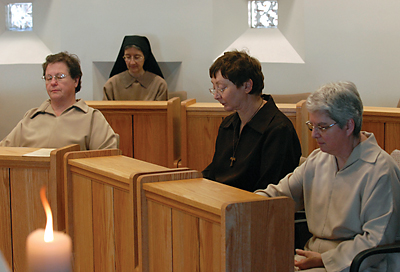
 TRAVELERS REST—The Order of Poor Clares are an international community of cloistered nuns dedicated to the task of surrounding the world with prayer.
TRAVELERS REST—The Order of Poor Clares are an international community of cloistered nuns dedicated to the task of surrounding the world with prayer.
Founded in Italy by St. Francis of Assisi and St. Clare, they number over 20,000 women throughout 70 countries, 30 of which are in the United States, according to their Web site, www.poorclare.com and www.poorclaresc.com.
The sisters have remained true, for almost 800 years now, to the tradition of Sts. Clare and Francis and are dedicated to a life of prayer, poverty and community.
St. Clare
Clare was born in Assisi, Italy, in 1193. Her name, which means light, was chosen by her mother, who, while praying in church for a safe delivery, heard a voice that told her she would “bring forth a light which will illumine the world.”
Her family was wealthy, and though Clare was raised among the nobility, she cared little for the social life, preferring to pray and help the poor. She often gathered the remaining food from dinner and gave it to those in need.
Clare probably heard Francis preach in the Cathedral of San Rufino, which was next to her family’s castle. She was attracted to his message and devotion to God, but her father wanted her to marry a nobleman.
Determined to follow her calling, she left home in the middle of the night and was received by Francis of Assisi and a group of Friars Minor at Our Lady of the Angels chapel in 1212.
This marked the beginning of the contemplative branch of the Franciscan Order of Poor Ladies.
Clare died on Aug. 12, 1253, and was canonized by Pope Alexander IV just two years later on Aug. 15, 1255. Her remains are buried under the high altar of the Basilica of Saint Clare.
A prayerful mission
Like St. Clare, the Poor Clares are cloistered, which means they usually live in one monastery for their entire lives.
The Poor Clare nuns explain that each community is autonomous and has its own abbess.
They have similarities because all the nuns bring gifts of prayer, simplicity, community and joy to the church, and the orders follow the same rule and share the same basic constitution. But they are also very different.
Sister Mary Connor, abbess of the monastery in Travelers Rest, said not all Poor Clares dress alike, perform the same work, or follow the same daily schedule.
She said most monasteries have between four and 16 members, although some are larger.
The Web site states: “the Poor Clare charism is one of family and St. Clare guided us that small communities are much better to keep this family spirit than larger ones.”
When growing communities reach a certain number, they will start new ones in order to maintain their quiet life of prayerful contemplation and closeness.
Such was the case with the Poor Clares in Jamaica Plain, Mass. Sister Mary said the order was “bursting at the seams” when an invitation came from Bishop John J. Russell of the Diocese of Charleston and the provincial of the Holy Name Province of Franciscan Friars.
Moving South
A new monastery opened in the Upstate in 1955, at a time when South Carolina was a mission area for Catholics. Sister Mary said even those who weren’t Catholic were warm and welcoming, and appreciative of the nuns life of prayer.
“Of course we pray for the whole world, but every day we say a prayer for the church of Charleston and the people of the state,” she said.
Recently, the sisters moved from a bustling area of Greenville to their new monastery, which is surrounded by green rolling hills and trees. Nestled in the woods of that property is the order’s ecumenical retreat house named La Foresta. It is one of the ways the sisters help support themselves.
They also provide most of the Catholic churches in the state, plus other denominations and churches outside the state, with altar bread. Sister Mary said it is their main means of financial support.
However, it is not their primary job.
“Our main work is prayer,” she said.
Helping the world
The abbess said a person could come to the convent and go into seclusion from the outside world, but would still know what was happening just from the sisters’ prayers.
Although they have a certain structure, and some prayers, such as those for peace, are said by everyone, others are individual. Sister Mary said one nun has recently been praying daily for people suffering from AIDS. Another sister always prays for children in school, especially those who are struggling.
“The prayers can be infinite,” Sister Mary said.
From dawn until …
The Poor Clares’ daily activities revolve around communal and personal prayer.
They begin their day with individual prayer and have communal Morning Prayer at 7:20 a.m., followed by a Eucharist service at 9 a.m.
Sister Mary said in the early days, the Franciscan friars served as their chaplains. Now, Franciscan Father Patrick Tuttle, pastor of St. Anthony of Padua Church in Greenville, celebrates Mass a couple of times a week, as do other priests in the area.
Manual work is kept simple so the nuns can be prayerful as they perform their tasks, the abbess said. They have two work periods a day: 10 a.m. to noon and 2:40-4:30 p.m.
The Office of the Readings at noon is followed by their main meal, a time when all the nuns gather for food and fellowship.
Interspersed in the day are midday, mid-afternoon, evening and night prayers, which ends the nuns’ day by 7:15 p.m.
